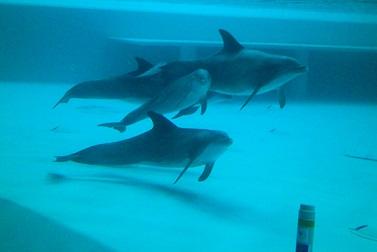The bottlenose dolphin

The most well-know of all small cetaceans is presumably the bottlenose dolphin (Tursiops truncates).
Due to the wide distribution of this species, bottlenose dolphins exploit a wide variety of habitats. They are found in bays, lagoons, river mouths, seabed areas and occasionally travel up into rivers. Their habitat ranges from shallow tropic waters and estuaries to the deepest trenches of the open ocean, with temperatures ranging from less than 0°C to more than 30 °C. Many populations are found to inhabit coastal waters.
The bottlenose dolphin is a very social species, with group sizes of 2-15 animals, but large ‘super-pods’ of hundreds or even thousands of animals are regularly witnessed. Dolphins communicate primarily with whistles, mainly in the audible frequency range. The most studied whistle type is the so called ‘signature whistle’. These whistles are individually distinctive and are believed to be contact calls and convey identity information in order to maintain group cohesion, which is particularly important when a free-ranging group lives in murky waters, but is also used when dolphins are separated in a pool complex.
Pulsed sounds are also used for communication purposes, and can be recognized by their frequency content and inter-click interval (or click repetition rate) patterns that are different from clicks used for echolocation.
Echolocation evolved independently in two mammalian groups, bats and toothed whales, or odontocetes. In both bats and odontocetes, echolocation is mainly used for orientation and foraging.
Odontocetes produce sonar clicks within their nasal passages by pushing air upward across the so called phonic lips, with rod-like dorsal bursae embedded inside. These sonar clicks are then transmitted through the fatty melon on the dolphin’s forehead, which creates a beam of sound which emerges from the forehead of the dolphin. Bottlenose dolphins wait for the echo to return before emitting the next click. Normally there is a lag time between receiving the echo and the emission of the next click, which is typically between 20-40ms. The inter click interval or ICI at a 1m range whilst scanning the object is between 10-25 ms, about 50ms from a distance of 20m and 175-190ms from a distance of 120m. The ICI is measured 2-3ms during prey pursuit or at close range.
Bottlenose dolphins have excellent hearing, they possess three times more ganglion cells than the human ear and a longer cochlear channel, which enables them to hear and discriminate between high frequency sounds perfectly. Even in a noisy environment, they are able to detect and classify weak signals.
During orientation and prey pursuit tasks, varies patterns in the echolocation pulses can be recognized. Two major phases are known, the search and the approach phase. The search phase typically has the longest pulse durations and ICI, and is also referred to as ‘scanning’. During the approach phase, the pulse duration and ICI decrease, which can be divided into an initial and a terminal part, the latter also referred as a ‘buzz’. The approach phase starts after the echoes from a suitable prey are detected. The ICI in the initial part is distinctly longer than the ICI in the terminal part, which occurs at distances between 1.9 – 4.4m from the prey in harbour porpoises. The terminal part of the approach phase, the buzz, occurs when harbour porpoises are at a distance between 1.9 and 4.4m from the object, and a sudden drop in ICI can be observed, from around 50ms to below 10ms. In the last stage of the buzz phase ICI values of between 1.4 – 16 ms can be seen.
Captivity is found to have some effect on the echolocation behaviour of the bottlenose dolphin. One study, comparing click-trains between captive and wild bottlenose dolphins reported that most click-trains from wild individuals showed a fluctuating type click-train with irregular ICI change and without increment or decrement, which is suggested to be used when dolphin scan their surroundings but are not locked onto a specific target. However, most click-trains from captive dolphins showed more monotonous ICI decrement, similar to decreasing type click-trains, and were suggested to be correlated to a target range, which is often absent in wild bottlenose dolphins. Akamatsu and colleagues (1998) found that captive bottlenose dolphins adapt their echolocation to short-range detection or navigation.
Responsible for this page:
Director of undergraduate studies Biology
Last updated:
05/13/15
